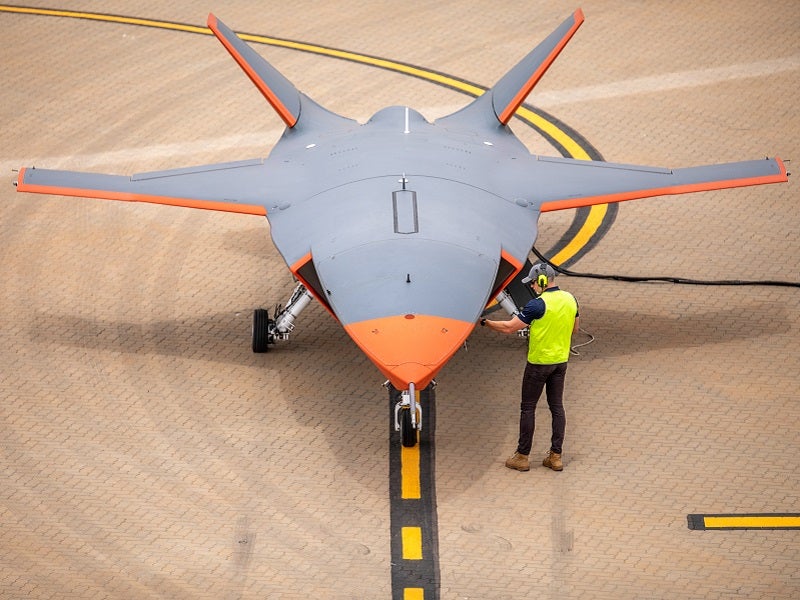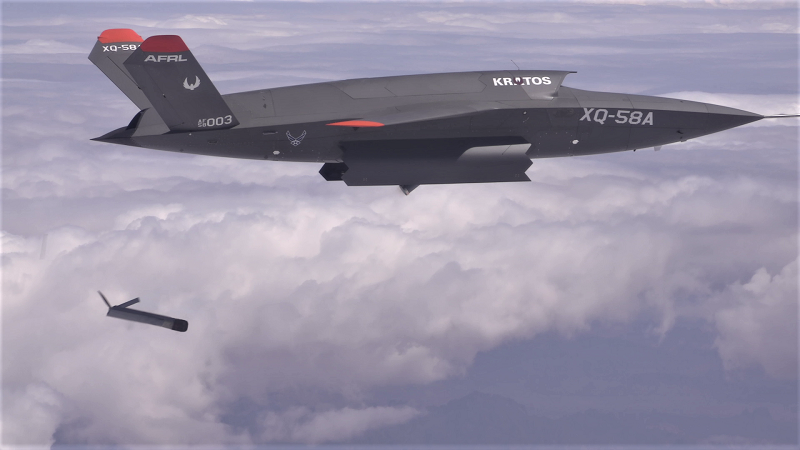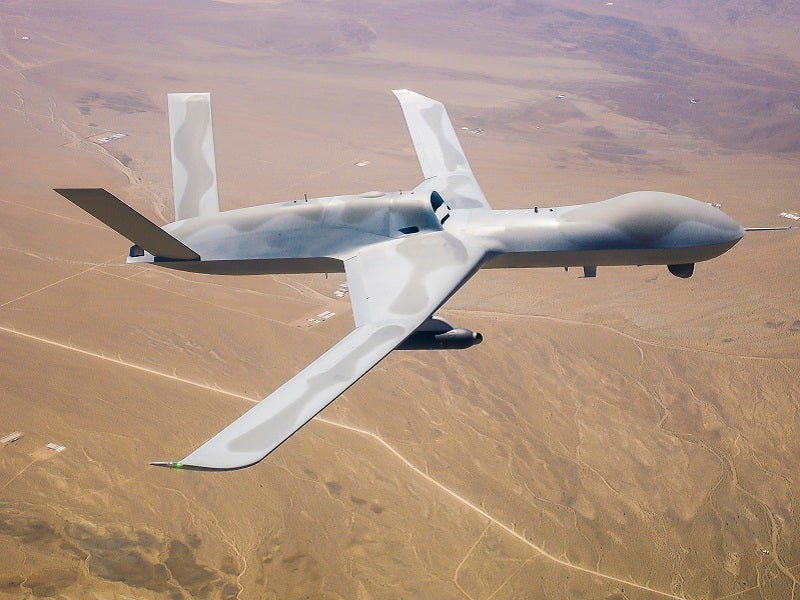
With the rising cost of crewed aircraft the intention is to add types of autonomous aircraft, such as UCAVs, into air force fleets, not only to increase numbers and create mass for operations but also to have an ability to sustain aircraft losses that would not be possible with manned platforms.
Loyal Wingman aircraft are set to become an essential part of the inventory for any modern air force that wants to keep pace in the era of great power competition. They will be essential to conduct operations in a high threat environment against near-peer states equipped with powerful anti-air capabilities.
US and Australian initiatives
The US Air Force (USAF) is the obvious leader in this field and in March 2019 it launched the Skyborg programme. Skyborg aims to introduce a new UCAV platform and supporting artificial intelligence (AI) system – known as the Autonomy Core System – as a way of bringing a Loyal Wingman capability into USAF service.
Prototype Skyborg UCAV aircraft are being built by three companies under a series of contracts awarded in December 2020. Kratos was given $37.7m to develop its XQ-58A Valkyrie system, General Atomics ASI was awarded $14.3m and Boeing received $25.7m.
In 2021, following trials using the Kratos UTAP-22 uncrewed air vehicle the Skyborg programme was then classified by the USAF and therefore no further information has been available. But prior to this it was known that Kratos was building 12 Valkyrie aircraft with completion due by early 2023. It is believed that Valkyrie has flown using the ACS and with a series of different payloads including EO/IR sensors, small-UAVs and communications systems.

GA-ASI has been flying its MQ-20 Avenger UCAV to support USAF’s ambitions for autonomy. This includes tests with Lockheed Martin’s Legion Pod system and completing Manned-Unmanned Teaming with a King Air aircraft playing the role of a surrogate for fourth and fifth generation aircraft.
How well do you really know your competitors?
Access the most comprehensive Company Profiles on the market, powered by GlobalData. Save hours of research. Gain competitive edge.

Thank you!
Your download email will arrive shortly
Not ready to buy yet? Download a free sample
We are confident about the unique quality of our Company Profiles. However, we want you to make the most beneficial decision for your business, so we offer a free sample that you can download by submitting the below form
By GlobalDataIt is believed that Boeing is using its Airborne Teaming System (ATS) as part of the Skyborg programme, but it is unclear what tests have been completed. The ATS is being developed in Australia under the Air Force Minor Program DEF 6014 Phase 1 as the MQ-28A Ghost Bat.
In May 2022 during the Australian general election, it was announced by former Australian Prime Minister Scott Morrison that the Ministry of Defence (MoD) would be procuring seven Ghost Bat aircraft for Royal Australian Air Force (RAAF) for A$454m. This will be on top of the A$155m that was provided for the procurement of three prototypes plus an initial three production aircraft. The three prototypes will not be owned or operated by the MoD or RAAF.
However, the latter three plus the additional seven will provide 10 aircraft overall for the RAAF. These are slated to become operational by 2024-25.
The first three prototype Ghost Bat have been delivered with flight tests completed on the first pair in 2021. A first flight test for the third aircraft is expected in 2022. The US and UK are observing the project.
European UCAV efforts
In Europe there are two major Loyal Wingman UCAV programmes underway. France, Germany and Spain are jointly developing a crewed fighter called the Next Generation Fighter (NGF) also known as the Système de Combat Aérien Futur (SCAF/FCAS). But under the Next Generation Weapon System (NGWS) part of the programme a new Remote Carrier (RC) autonomous platform will also be developed.
The RC aircraft is begin built by Airbus and will be tasked with a variety of roles including as a weapons carrier, ISR and EW platforms and decoy aircraft. Under plans announced in August 2021, the intention is for prototypes of both the manned fighter and RC aircraft to be flying by 2025, but this date has slipped to 2028.
The main challenges introducing Loyal Wingman aircraft into service have less to do with the technology, which has been around for two decades, but with the communications capability
This work is being accelerated under Implementation Agreement 3 component of the first two phases of effort that is pushing the entire NGF demonstrator project forwards. Although the RC aircraft is expected to fly sooner than 2028 the current Phase 1B and Phase 2 parts of the NGF project have been halted since March 2022 because of an industrial dispute between Airbus, Dassault and Indra on the workshare arrangements for the crewed fighter. Work is expected to start once this has been resolved.
A spokesperson for Airbus told Airforce Technology that discussions about FCAS including NGF “are on-going to finalise the negotiations as soon as possible and be able to launch the next phase – the so-called Demonstrator phase 1B.”
The spokesperson added that the company has performed a new demonstration activity with the RC platform “related to manned-unmanned teaming during mid-2022”.
A fully operational FCAS system is expected to be deployed by 2040, but with the current dispute ongoing causing additional time slippages this date is unlikely to be achieved.
Meanwhile the UK and Italy are pursuing their own FCAS project dubbed Tempest. At the Farnborough Air Show in July, 2022, it was announced by the UK MoD and industrial partners BAE Systems, Leonardo, Rolls-Royce, and MBDA that a demonstrator aircraft would be flying within five years.
There is also the prospect of Japanese involvement in the programme to consider. Tokyo is already part of the joint concept and analysis work but decisions about a Japanese partnership and a potential merger of Tempest and the latter’s existing F-X fighter project are expected by the end of 2022. Concept analysis is underway with full development to begin in 2024 and a prospective entry into service expected in 2035.

Like the Franco-German-Spanish FCAS effort it requires complex planning about the workshare for the industrial bases in the partner nations. Sweden has also been involved in Tempest but officials from Saab have stated that the company and Sweden are reducing their commitment to the project until it is properly established by UK, Italy and Japan.
Meanwhile a second UK-led effort to develop a low-cost uncrewed fighter called the Lightweight Affordable Novel Combat Aircraft (LANCA) under Project Mosquito was cancelled by the Ministry of Defence’s Rapid Capabilities Office in June 2022. A first flight for LANCA had been expected in 2023.
Contractors Spirit AeroSystems and partners Northrop Grumman UK and Intrepid Minds, which had been awarded a Project Mosquito £30m Phase 2 design and development contract as recently as January 2021, announced that Phase 2 work had stopped “at the end of the material design phase” so no demonstrator air vehicle had been built.
Developmental challenges
Although there are other single nation efforts being undertaken by India, Russia and South Korea to develop uncrewed variants of their fighter aircraft the efforts by the US, Australia and European countries are the most advanced.
The main challenges introducing Loyal Wingman aircraft into service have less to do with the technology, which has been around for two decades, but with the communications capability to address how they will operate in a contested electronic environment and the concept of operations detailing exactly how they will be used to complete missions.
Despite the impression given by marketing material, Loyal Wingman aircraft they are unlikely to operate alongside crewed platforms due to safety. Autonomous UCAVs will have to operate at a distance.
Furthermore, Loyal Wingman aircraft are mainly developed for ground attack roles and more work is needed to advance the air-to-air capabilities to reach the same capability as crewed aircraft. But ultimately these platforms must remain affordable to ensure that they can complete missions at lower cost or Loyal Wingman platforms won’t be able to offer the mass that air forces need.







